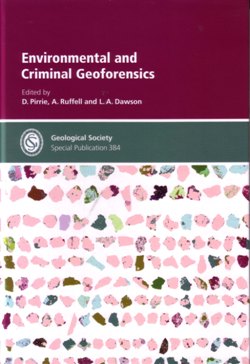
The application of geological sciences is quite varied and has many practical uses. In summarizing the strengths of Sherlock Holmes in A Study in Scarlet, Dr John Watson considers his knowledge of geology to be limited but focused saying “he could identify any soil in London and the borough it came from” (Doyle, 1887). This perhaps is a good reflection of the purposes of geological knowledge in forensic science.
The lack of literature on the application of geological sciences to forensics is reflected in the short reference lists in each of the chapters in this special publication of the Geological Society that is the culmination of a series of meetings held in 2010. Despite the paucity of publications the importance of geology in forensics was recognized as early as 1856 when silver coins placed in barrels were switched with sand and ballast on a train from Lepzig to Berlin. Using the geological characteristics of the sand, the most likely location was identified and led to recovery of the coins (Pirrie et al, 2013).
With such limited information in the literature this book is highly pertinent but not only to a study of forensics but also for a wider audience interested in site characterization work, particularly in soil science. The twenty chapters presented in the book are, on the whole, well produced and the book has been completed to the high standard one has come to expect of the Geological Societies special publications. Few typographical errors are present in the book with minor mis-labelling on some figures.
The papers in the book can be divided into three groups; Analytical approaches to material characterization; Exploration approaches utilizing geology, geochemistry and geophysics in superficial materials; and case studies related to environmental or criminal cases where application of geological knowledge has been pertinent.
The analytical chapters lean heavily towards mineralogical applications and include assessment of the use of polarizing microscope; the use of portable XRF and laboratory XRD particularly in relation to soil characteristics and the application of more automated versions for soil sample classification and province of samples. The application of instrumental neutron activation analysis, microbiology, palynology, good database management and organic geochemistry are also presented richly illustrated by case studies. In mapping of near-surface anomalies papers are presented on the use of geological and geomorphological mapping as well as geophysics to such varied studies as environmental impacts, change in land use, the search of precious metal artefacts and application of various geophysical techniques to locating buried weapons.
The book is strongly recommended to those who teach basic techniques of geological investigation as a source of novel case studies of the relevance of geological, mineralogical, geochemical and geophysical site characterization techniques. I am sure for those involved in criminal and environmental forensics this book will be essential reading and will come to be an important source of background information for such investigations. However anyone involved in the study of soils and sediments will find the book an invaluable source on material characterization techniques and for this reason alone the book is strongly recommended.
by Rob Bowell
Reference:
Doyle AC (1887) A study in Scarlet. Beeton’s Christmas Annual. Ward & Lock Co., London.
ENVIRONMENTAL AND CRIMINAL GEOFORENSICS: AN INTRODUCTION
Pirrie D, Ruffell A, Dawson, LA (2013) . In: Environmental and Criminal Geoforensics Geological Society, London. Special Publication, 384, 1-7.